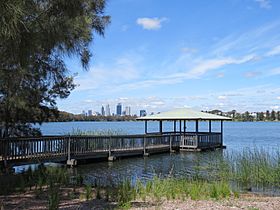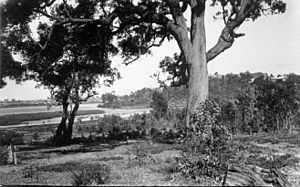Lake Monger facts for kids
Quick facts for kids Lake Monger |
|
|---|---|

The view from the northern shore of Lake Monger with the Perth skyline in the background
|
|
| Lua error in Module:Location_map at line 416: Malformed coordinates value. | |
| Location | Perth, Western Australia |
| Coordinates | Lua error in Module:Coordinates at line 614: attempt to index field 'wikibase' (a nil value). |
| Type | Wetland |
| Native name | Keiermulu (Nyungar) |
| Basin countries | Australia |
| Designation | Lake Monger Reserve |
| Surface area | 0.7 km2 (0.27 sq mi) |
| Shore length1 | 4.5 km (2.8 mi) |
| Islands | 1 |
| 1 Shore length is not a well-defined measure. | |
Lake Monger (called Keiermulu by the Noongar people) is a large wetland in suburban Perth, Western Australia. It sits between the suburbs of Leederville, Wembley, and Glendalough.
This beautiful lake is less than 5 kilometres (3.1 mi) from the city of Perth. It covers about 70 hectares (170 acres) of shallow water. There is also a small island of 1.3 hectares (3.2 acres) in its south-west corner. The entire area, including the lake and its surrounding parklands, is known as the Lake Monger Reserve. It spans 110 hectares (270 acres).
Lake Monger is a very popular spot for fun activities. Many people visit it, sometimes up to 12000 visitors each week! You can enjoy bird watching or get some exercise. A 3.5-kilometre (2.2 mi) paved path goes all the way around the lake, perfect for walking or cycling. You'll also find car parking, playgrounds, and barbecue areas for visitors.
Contents
How Lake Monger Got Its Name
The Indigenous Noongar people, who lived in this area first, had several names for the lake. They called it Keiermulu, which means "the home fires or camp". They also knew it as Lake Galup or Lake Kalup.
After European settlers arrived, the lake was first called Large Lake or Triangle Lake because of its shape. In 1831, it was named Monger's Lake. This was after John Henry Monger, an early land owner. In April 1932, its name was officially changed to Lake Monger, which it is still called today.
Lake Monger's History
Ancient History: Before European Settlers Arrived
Lake Monger was once part of a big group of wetlands. These wetlands stretched for about 50 kilometres (31 mi) north from the Swan River.
We don't know much about how the Noongar people used the lake before the British arrived. However, we know it was an important area for them. It was likely a great place for camping and hunting. They would have hunted black swans, other wildfowl, turtles, frogs, and fish like gilgies and mudfish for food.
The Wagyl Story
The Noongar people have a special story about the lake. It involves a mythical serpent-like being called the Wagyl. The story says that the Wagyl was traveling towards the sea. On its journey, it came out of the ground, and this created Lake Monger. The lake and a big part of the reserve are important Aboriginal heritage sites. They hold historical and mythological meaning for the Aboriginal people.
European Settlement and Changes

In 1829, British explorers started the Swan River Colony nearby. In 1830, there were some small fights at Lake Monger. These were between white settlers and Noongar men, including one named Midgegooroo.
After the colony began, Lake Monger was part of a larger area called The Great Lakes District. Many wetlands in this district were drained. This was done to create more land for farming and new parks. Sadly, between 49% and 80% of the wetlands on the coastal plain have been lost since 1832. Lake Monger and Herdsman Lake are now two of the last major wetlands close to the city.
By 1832, the land around the lake was divided into different plots. John Henry Monger bought a southern plot. William H. Leeder also bought land nearby, which is now the suburb of Leederville. In 1833, a special "reserve" was set aside for Noongar people.
In 1902, a group was formed to manage the lake. In 1909, a drain was built to connect the lake to the Swan River. This allowed people to control the water level, and this drain is still used today. By 1912, the lake covered 111 hectares (270 acres).
In the 1920s, the City of Perth started buying land around the lake. This land had been used for Chinese market gardens and dairies. The city wanted to turn it into public parks. By 1930, 50 hectares (120 acres) of land had been bought to become part of the Lake Monger Reserve.
Developing the Lake for Recreation
In May 1932, work began to make the lake better for people to use. They started dredging, which means removing mud and silt from the bottom. This helped to reclaim 20 hectares (49 acres) of swampy land. By June 1933, they had pumped out 110,000 tons of silt!
Much of the plants around the edges of the lake were removed. They were replaced with grassy lawns. The southern shore was developed with a kiosk, bathing sheds, a boat house, and a jetty. People used the lake for picnics, sailing, swimming, and fishing.
However, by 1936, the water quality got worse. There were also many annoying midges (small flies). Between 1950 and 1964, more wetlands were filled in with landfill. This helped reclaim even more land around the lake.
In the 1960s, a small island was created in the south-western corner of the lake. This island was built to be a safe place for birds.
In 2006, a local school found many dead fish in the lake. It was discovered that fertilizer from nearby lawns was washing into the drains and polluting the water. This fertilizer contained phosphorus, which is harmful to the lake. In 2008, heavy rains caused parts of the lake to flood. This created new small islands and coves.
In 2019, a strong bad smell was noticed near the lake. It was caused by rotting algae.
Plants and Animals of Lake Monger
Lake Monger is home to many different plants and animals. The island built in the 1960s provides a summer home for birds. Over 38 different types of birds have been seen here! These include beautiful black swans, cormorants, spoonbills, and large pelicans.
The lake also has southwestern snake-necked turtles, big skinks, and two kinds of frogs. The fish in the lake are all species that were brought here by people. They include goldfish, carp, mosquito fish, and English perch.
In the 1800s, the area around the lake was covered in swamp trees. These included Melaleuca rhaphiophylla, Banksia littoralis, and Eucalyptus rudis. Other common plants were Xanthorrhoea (also called balga or grasstree), rushes, wattle, and tea tree. But as land was reclaimed, many rushes were removed to make way for lawns and sandy beaches. Today, there are not many banksia trees left, and only a few paperbark trees. Most trees are now found in a narrow strip around the lake's edge, mainly on the northern and eastern sides.
Images for kids



